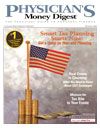Publication
Article
Physician's Money Digest
What Does "Inverted Yield Curve" Mean?
Author(s):
Recently, I have receivedsome calls from physicianson a rather obscuretopic—the relationshipbetween the so-called invertedyield curve and how it has oftenbeen a harbinger of a recession.
The relationship between short-termand long-term interest rates is such thatlonger-term interest rates have generallybeen higher than short-term rates. Thegraphical depiction would be one wherethe yield curve is sloping upward. Whenthe opposite occurs, the yield curve issaid to be "inverted." These inversionsare rather uncommon. In fact, over thelast 4 decades, this inverted yield curvehas predicted many of the past recessions.In two instances, 1966 and 1998,the yield curve was inverted when long-termrates were in the range of 4.5% to5%, and no recession followed.
A Case in Point
As of the writing of this article, theyield curve is slightly inverted. Is this anomen for disaster? Not necessarily. Thefollowing example will explain why.Suppose you have two bonds. One bondmatures in 1 year and the other bondmatures in 2 years, and both have yieldsof 5%. You have the choice of alternatives—purchasing a 2-year bond yielding5% and holding it to maturity or purchasinga 1-year bond at 5%, holding itfor 1 year, and reinvesting the proceedsfor another year. If interest ratesremained at 5%, the investor would beindifferent between the two. But if short-terminterest rates were expected to dropnext year to 4%, the investor would preferthe 2-year bond, which provides a5% yield, vs an average yield of 4.5%from the rollover strategy.
Examine the Theories
This creates a situation where thedemand for the 2-year note would increase,driving up the price until theactual yield falls below that of the 1-year note. These forces of supply anddemand will ensure that the 2-year noteis the average of today's 1-year rate andthe 1-year rate expected next year.Today's inverted yield curve may beexplained by investors' expectationsthat interest rates are likely to fall.
Again, the easiest way to explain therisk premium theory is by way of example.An investor holding a short-termnote, regardless of the volatility of interestrates, knows that the note will shortlybe converted into cash with no loss ofprincipal. However, investors holdinglonger-term notes bear the risk of sufferingcapital losses should inflation accelerateand the Federal Reserve, to keepinflation in check, raises interest rates. Tocompensate investors for the additionalrisk borne as a result of holding longer-termas opposed to shorter-term notes,investors must be compensated in theform of a risk premium to induce themto hold longer-term instruments. Thisrelationship causes the yield curve to beupward sloping, which is the traditionalslope of the yield curve. Now, if becauseof better monetary policy the risk premiumsdemanded by bond investors was todecline, this could cause the yield curveto invert. So, if lower-risk premiumsdemanded by investors are partly responsiblefor the slope of today's yield curve,investors have no reason to fear animpending recession just because thecurve is inverted.
This theory suggests that the slopeof the yield curve is determined by investors' preferences to hold shorter-orlonger-term securities. For instance, ifinvestors prefer to hold longer-as opposedto shorter-term securities, andhence the demand for long-term capitalis strong relative to the supply ofsuch capital, then the yield curve willbe sloping upward. As such, supplyand demand considerations mighthave contributed to the current yieldcurve inversion.
So, is today's yield curve a portent fordisaster? Hopefully not. Treasury rateshave been relatively stable, inflationappears to be contained, and currentmonetary conditions have in no way stifledeconomic growth. Hence, no recessionand no bear market for equities islikely on the horizon.
Thomas R. Kosky and his partner, Harris L.Kerker, are principals of the Asset Planning,Group, Inc, in Miami, Fla. The companyspecializes in investment, retirement, andestate planning. Mr. Kosky also teaches corporatefinance in the Saturday Executive and Health CareExecutive MBA Programs at the University of Miami in CoralGables, Fla. Mr. Kosky and Mr. Kerker welcome questions orcomments at 800-953-5508, or e-mail Mr. Kosky directly atProfessorKosky@aol.com.
